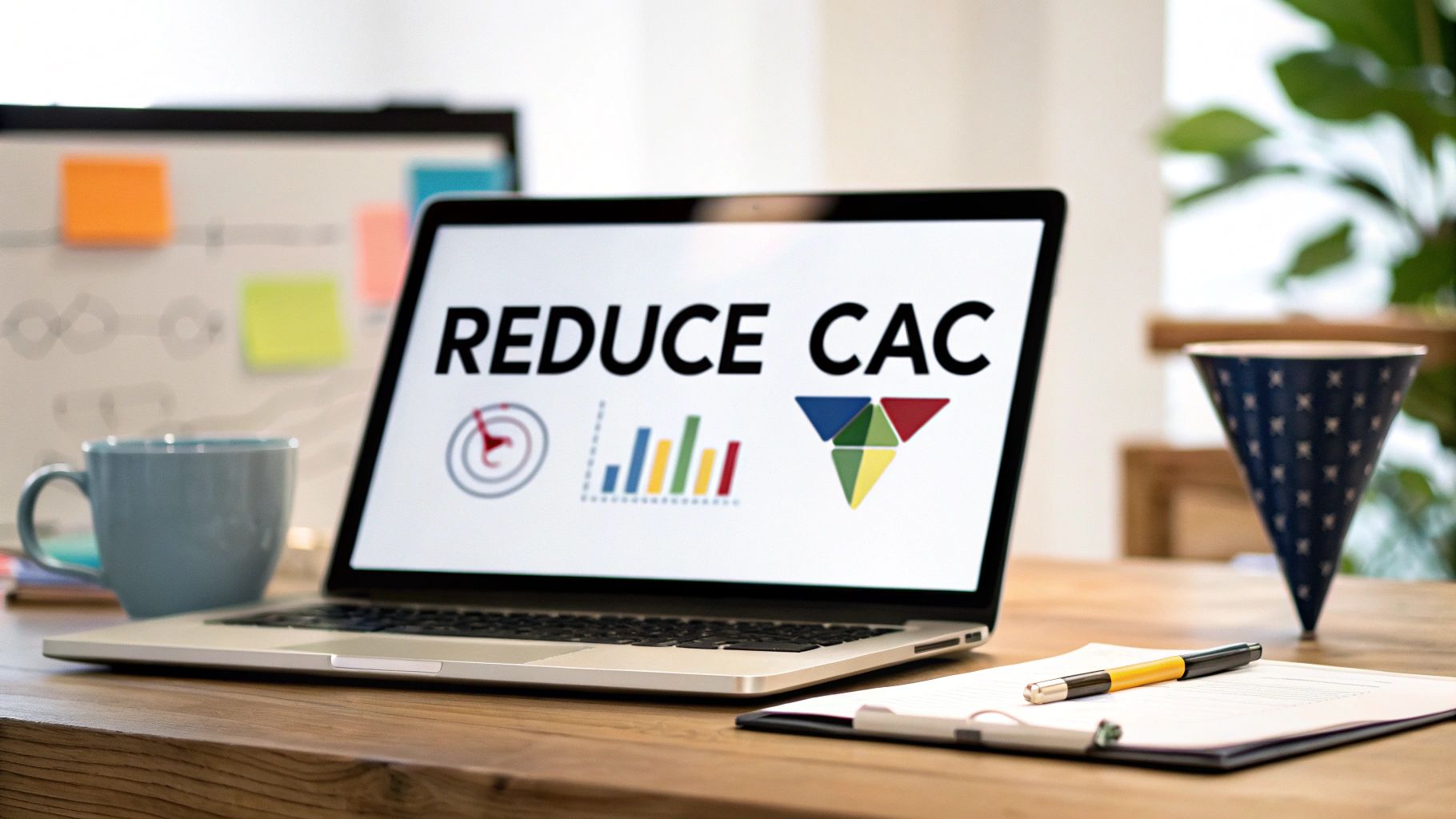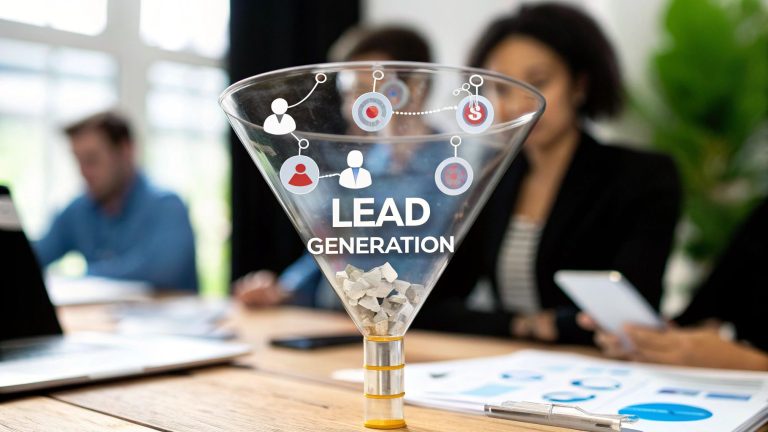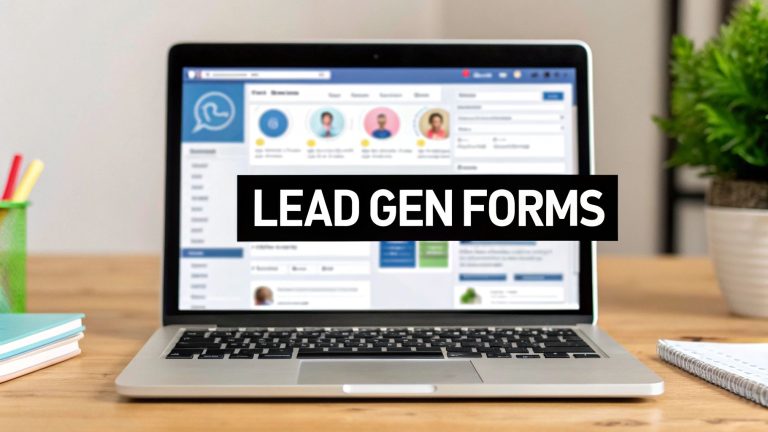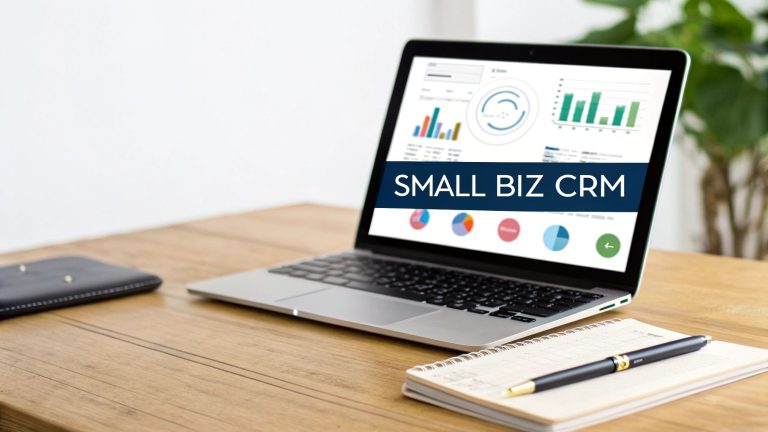7 Proven Ways to Reduce Customer Acquisition Cost in 2025
Stop Overspending: Your Blueprint to Smarter Customer Acquisition
Acquiring new customers is the lifeblood of any growing business, but it often comes at a steep price. Skyrocketing ad spend, inefficient campaigns, and missed opportunities can quickly drain your marketing budget, leaving you with a high Customer Acquisition Cost (CAC) and a shrinking bottom line. The relentless pressure to grow can push businesses into a cycle of expensive, short-term tactics that are simply not sustainable. The core challenge isn't just about spending money to get customers; it's about spending it wisely to acquire the right customers efficiently.
This guide provides a comprehensive blueprint to help you systematically reduce customer acquisition cost. We will move beyond generic advice and dive deep into actionable strategies that deliver measurable results. You will learn how to build a powerful, cost-effective acquisition engine by leveraging a multi-faceted approach. This isn't about slashing your budget; it's about optimizing every dollar you spend for maximum impact.
We will explore seven critical areas designed to lower your CAC and boost your profitability. From harnessing the long-term power of inbound marketing and SEO to optimizing every conversion point on your website, each section offers practical steps you can implement immediately. You'll discover how to transform satisfied customers into a referral engine, automate your outreach with precision, and build strategic partnerships that drive growth. This article is your detailed roadmap to stop overspending and start acquiring customers with greater intelligence and efficiency.
1. Inbound Marketing & Content Marketing
Instead of spending heavily on paid ads that interrupt potential customers, inbound marketing focuses on attracting them organically. This methodology, popularized by HubSpot founders Brian Halligan and Dharmesh Shah, revolves around creating valuable, relevant content and experiences tailored to your ideal audience. By addressing their pain points, answering their questions, and solving their problems, you build trust and establish your brand as an authority, drawing customers to you like a magnet. This approach is a powerful long-term strategy to reduce customer acquisition cost because the content you create becomes a lasting asset that generates leads and traffic for months or even years, unlike a paid ad that stops working the moment you turn off the budget.

The core principle is simple: be genuinely helpful. For example, Buffer, a social media management tool, built its early user base through a transparent blog that openly shared its journey, challenges, and revenue numbers. This authentic content resonated with its target audience of startups and marketers, creating a loyal community and driving massive organic growth without a huge ad spend. Similarly, Moz’s "Whiteboard Friday" video series became a go-to educational resource for SEO professionals, cementing their industry leadership and attracting qualified customers who already trusted their expertise.
How to Implement an Inbound Strategy
Executing a successful inbound marketing plan requires a systematic approach. It is not about randomly publishing blog posts; it is about creating a strategic content engine that consistently attracts and converts your ideal customer profile.
- Create Content Clusters: Don't just write about isolated topics. Build "topic clusters" around core business themes. This involves creating a comprehensive "pillar page" on a broad subject (e.g., "Lead Generation for Small Business") and linking it to multiple, more specific "cluster" blog posts (e.g., "5 Ways to Capture Leads from Facebook," "How to Write a High-Converting Landing Page"). This structure signals expertise to search engines, boosting your SEO authority and organic traffic.
- Focus on Problem-Solving: Every piece of content, from a blog post to a video tutorial, should answer a specific question or solve a tangible problem for your audience. Use keyword research tools to identify what your customers are searching for, then create the best, most comprehensive resource on the internet for that topic.
- Repurpose and Distribute: Maximize the value of every content piece. A single in-depth blog post can be repurposed into a video, an infographic, several social media posts, a podcast episode, and a chapter in an ebook. This multi-channel distribution amplifies your reach without requiring you to constantly create new material from scratch.
- Capture and Nurture Leads: Valuable content attracts visitors, but you need a system to convert them. Use compelling calls-to-action (CTAs) within your content to offer lead magnets like checklists, templates, or ebooks in exchange for an email address. Tools like LeadSavvy Pro can then be used to instantly capture these leads from your forms and alert your sales team, ensuring no opportunity is missed and the transition from marketing to sales is seamless.
2. Referral Programs & Word-of-Mouth Marketing
While paid advertising shouts a message from the rooftops, referral marketing whispers a trusted recommendation directly into a potential customer's ear. This strategy formalizes and incentivizes word-of-mouth, the oldest and most trusted form of marketing. By empowering your happiest customers to become brand advocates, you leverage their existing relationships and credibility. This approach is a cornerstone strategy to reduce customer acquisition cost because it transforms your customer base into a low-cost, high-performing acquisition channel that operates on trust rather than ad spend.
This strategy hinges on a powerful psychological principle: people trust recommendations from friends and family far more than they trust advertisements. PayPal's early growth, championed by Peter Thiel and Max Levchin, was famously fueled by offering a simple cash incentive ($10) for every successful referral. More recently, Dropbox's viral growth was driven by a genius dual-sided referral program that gave both the referrer and the new user extra storage space, which directly enhanced the product's value for its most engaged users and accounted for 35% of their daily signups.
This infographic provides a quick reference on why referral programs are so effective at lowering acquisition costs.
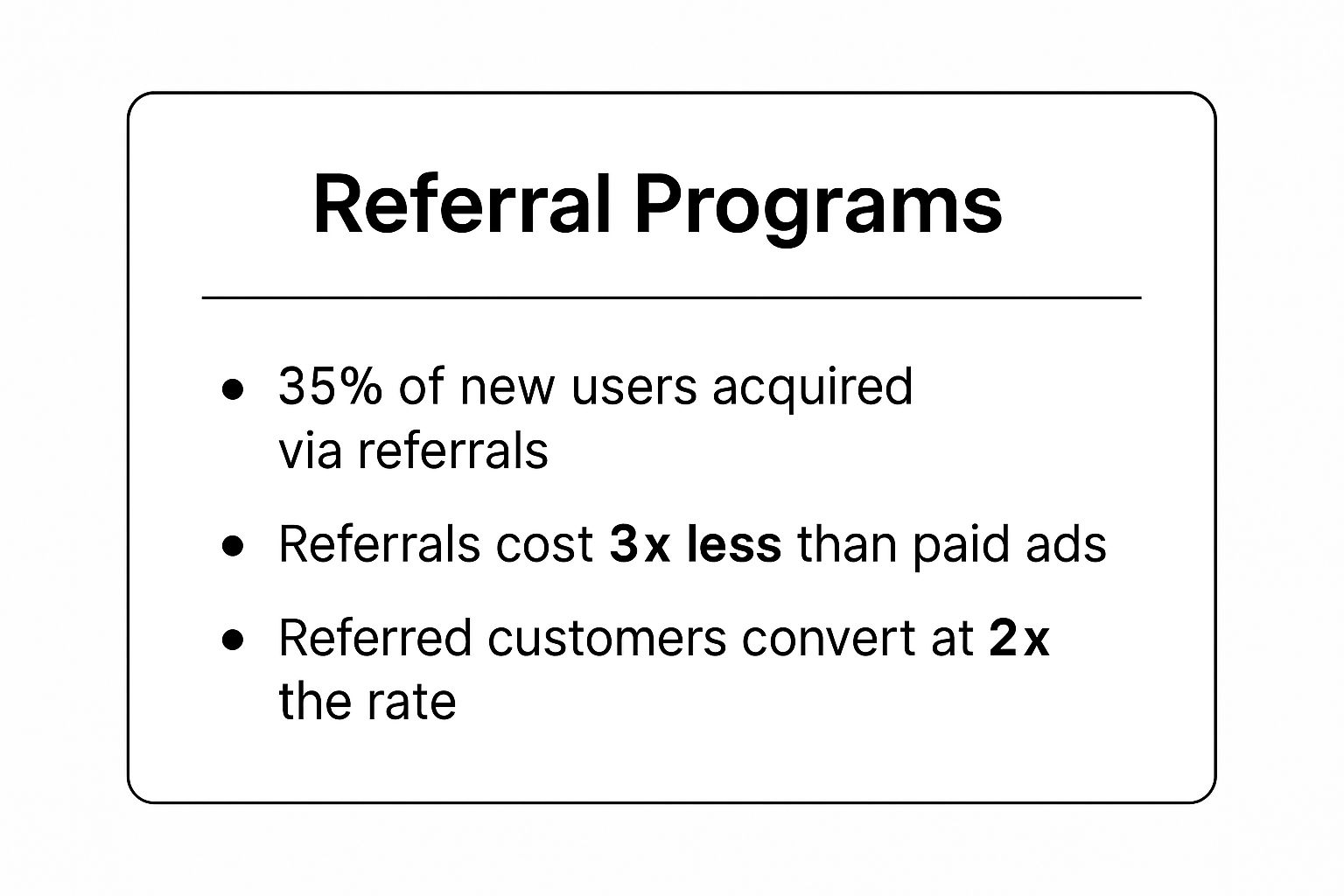
As the data shows, referred customers are not only significantly cheaper to acquire but also convert at a much higher rate, delivering superior ROI compared to traditional channels.
How to Implement a Referral Strategy
A successful referral program isn't just about offering a reward; it's about designing a frictionless experience that makes sharing easy and rewarding for your most loyal customers.
- Make it Effortless: The core of a great referral program is simplicity. Implement one-click sharing options with pre-populated messages for email, social media, and messaging apps. The less work your customer has to do, the more likely they are to participate. The goal is to remove every possible point of friction from the sharing process.
- Offer Dual-Sided, Valuable Rewards: The most effective programs reward both the referrer and the new customer. This creates a win-win scenario where the advocate feels good about giving a gift, not just getting one. Ensure the rewards are valuable and align with your product, like Uber’s ride credits or Dropbox’s extra storage, to reinforce user engagement.
- Time Your Ask Strategically: Don't ask for a referral at a random time. Trigger your referral prompts after a positive customer experience, such as a successful purchase, a five-star review, or a resolved support ticket. This capitalizes on moments of peak satisfaction when customers are most willing to advocate for your brand.
- Track and Optimize Your Funnel: Treat your referral program like any other marketing campaign. Track key metrics such as share rate, click-through rate, and conversion rate. Use this data to A/B test different offers, messaging, and calls-to-action (CTAs) to continuously improve performance and maximize the number of high-quality leads generated.
3. Search Engine Optimization (SEO)
Search Engine Optimization (SEO) is the practice of strategically enhancing your website and its content to rank higher in search engine results pages (SERPs) like Google. Instead of paying for every click, SEO focuses on earning organic, "free" traffic from users who are actively searching for the solutions, products, or information you offer. This is a foundational strategy to reduce customer acquisition cost because it targets users with high purchase intent at the precise moment they are looking for answers, turning your website into a powerful, self-sustaining lead generation engine. Each piece of optimized content acts as a digital asset that works for you 24/7, attracting qualified prospects long after its initial creation.
The power of SEO is evident in major success stories. Shopify, for instance, ranks for thousands of e-commerce-related keywords, from broad terms like "how to start an online store" to specific queries about shipping and payments. This attracts a massive volume of entrepreneurs who are prime candidates for their platform. Similarly, Backlinko's Brian Dean built a multi-million dollar business almost exclusively through SEO by creating definitive guides that dominated search results for highly competitive marketing terms. This approach establishes deep authority and trust before a user even becomes a lead.
How to Implement an SEO Strategy
A successful SEO plan is not about "tricking" Google; it's about systematically providing the best possible experience and answers for users. It involves a mix of technical precision, creative content, and strategic outreach.
- Target Long-Tail, High-Intent Keywords: Instead of chasing broad, competitive terms like "marketing software," focus on more specific "long-tail" phrases that indicate a user is closer to making a decision. Keywords like "best CRM for real estate agents" or "how to connect Facebook leads to my CRM" attract a more qualified audience and are often easier to rank for.
- Create Comprehensive, Authoritative Content: Aim to create the single best resource on the internet for your target keywords. This means going deeper than competitors by including detailed explanations, original data, expert quotes, and practical examples. This "10x content" approach signals to search engines that your page is the most valuable result for a user's query.
- Optimize Your Technical Foundation: Ensure your website is technically sound. This includes fast page load speeds, mobile-friendliness, and a clean site structure, which are all part of Google's Core Web Vitals. A technically optimized site provides a better user experience and makes it easier for search engines to crawl and index your pages effectively.
- Build High-Quality Backlinks: Backlinks (links from other websites to yours) are a crucial ranking factor, acting as "votes of confidence." Earn them by guest posting on reputable industry blogs, creating original research that others will cite, and forming strategic partnerships. Each quality backlink boosts your site's authority and visibility. To measure the impact of these efforts on your lead flow, you need to track your lead generation KPIs, which you can learn more about in this guide on lead generation KPIs.
4. Strategic Partnerships & Channel Partnerships
Instead of building an audience from zero, strategic partnerships allow you to tap into an existing, relevant customer base through collaboration. This approach involves teaming up with non-competing businesses, influencers, or platforms that serve the same ideal customer profile as you. By leveraging their established trust and reach, you can acquire new customers at a fraction of the cost of traditional advertising. This method is a powerful way to reduce customer acquisition cost because it is built on mutual benefit and shared audiences, creating a warm introduction rather than a cold interruption. The right partnership acts as a powerful endorsement, instantly validating your brand in a new market.
This strategy was famously leveraged by visionaries like Marc Benioff, who built the Salesforce ecosystem, and Daniel Ek, who integrated Spotify into countless other apps and services. A classic example is the early partnership between Spotify and Uber, allowing riders to control the music during their trip. This enhanced the Uber experience and introduced Spotify to millions of potential users in a contextually relevant moment. Similarly, Slack's extensive integrations with other business tools like Trello and Google Drive were not just features; they were a core acquisition channel, driving adoption as users pulled Slack into their existing workflows.
How to Implement a Partnership Strategy
Building successful partnerships requires more than just a handshake; it demands a structured approach to identify, vet, and nurture these valuable relationships. The goal is to create a win-win scenario where both parties see tangible growth and value.
- Identify Complementary Partners: Look for businesses that share your target audience but offer a different product or service. If you sell project management software, a partner could be a time-tracking app or an accounting firm. Analyze whose products your customers already use and love. The key is finding a natural, non-competitive fit.
- Define Clear, Mutual Goals: A successful partnership is built on a clear agreement. Outline exactly what each party will contribute and what success looks like. Define key metrics, such as leads generated, referral traffic, or co-branded sales. A formal agreement prevents misunderstandings and ensures both sides are aligned and accountable.
- Equip Partners for Success: Do not expect your partners to do all the work. Provide them with a "partner kit" that includes marketing materials, co-branded landing pages, email templates, and product training. The easier you make it for them to promote you, the better the results will be.
- Manage and Nurture Partner Leads: When partnership-generated leads start coming in, speed is critical. A delay can undo all the trust built by the partner's endorsement. Using a tool like LeadSavvy Pro ensures these high-value leads are captured instantly from co-branded forms or landing pages. Instant notifications allow your sales team to follow up immediately, referencing the partnership for a warm, contextual conversation that significantly boosts conversion rates.
5. Conversion Rate Optimization (CRO)
While many businesses focus on driving more traffic to their websites, Conversion Rate Optimization (CRO) concentrates on maximizing the value of the traffic you already have. This systematic process, championed by pioneers like Bryan Eisenberg and Peep Laja, involves improving your website and landing pages to increase the percentage of visitors who take a desired action. This action could be making a purchase, filling out a form, or signing up for a newsletter. By converting more existing visitors into customers or leads, you directly and effectively reduce customer acquisition cost without spending an extra dollar on advertising.
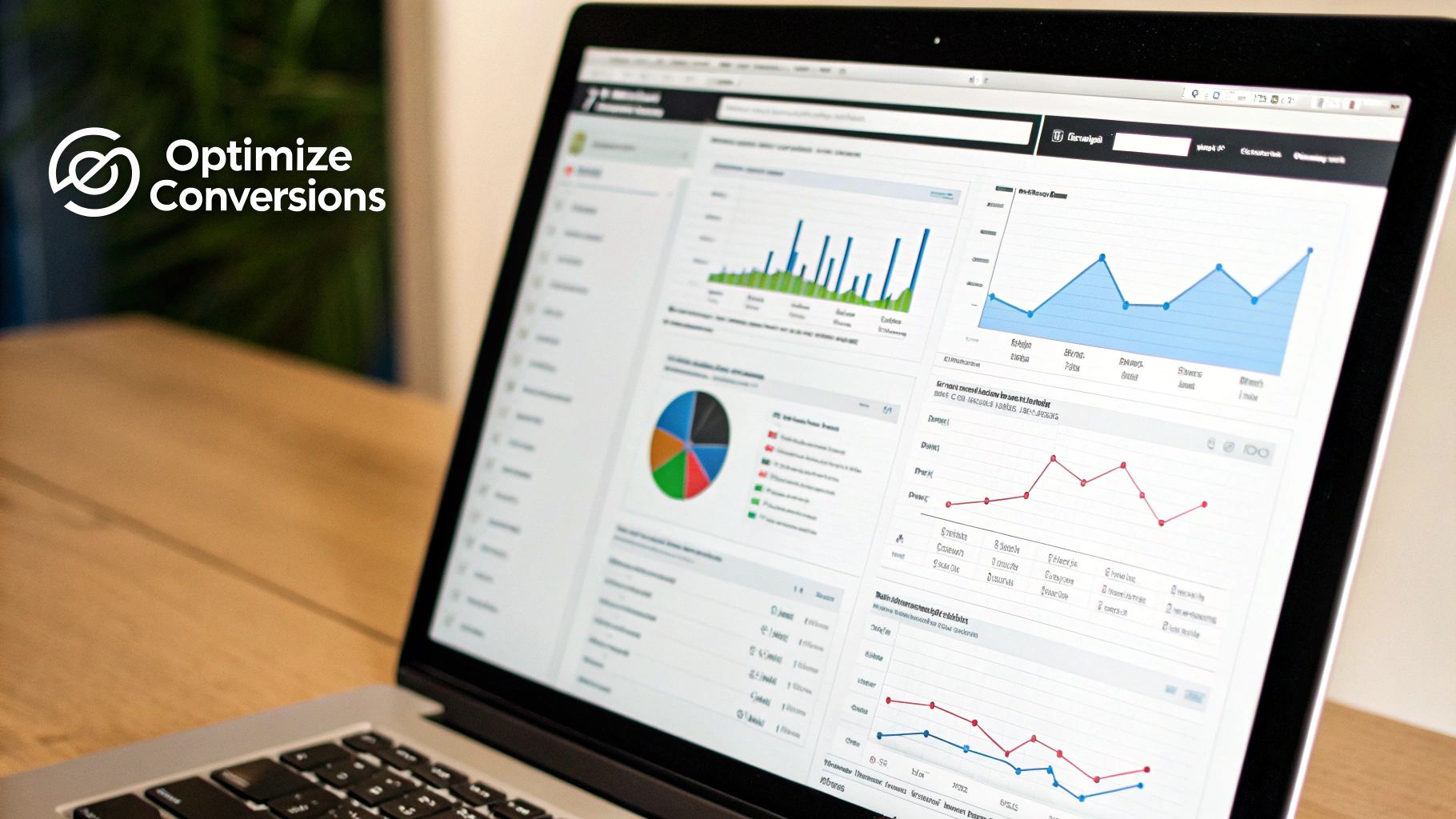
The power of CRO lies in small, data-driven changes that yield significant results. For example, Basecamp, a project management tool, saw a 14% increase in sign-ups simply by simplifying its homepage and focusing on a more customer-centric headline. In a more famous case, Barack Obama's 2008 presidential campaign raised an additional $60 million after A/B testing different combinations of website buttons and media, a testament to how minor tweaks can have a massive financial impact. These examples show that CRO is not about guesswork; it is a scientific method for turning more browsers into buyers.
How to Implement a CRO Strategy
A successful CRO plan is built on understanding user behavior, forming hypotheses, and testing them methodically. It's about removing friction and making it as easy as possible for a user to convert.
- Start with High-Impact Pages: Begin your optimization efforts on pages that receive the most traffic or are most critical to your conversion funnel, such as your homepage, pricing page, or key landing pages. Use analytics to identify pages with high traffic but high bounce rates or low conversion rates, as these offer the biggest opportunities for improvement.
- Test One Element at a Time: To get clear, unambiguous results, test only one variable at a time. This could be the headline, the call-to-action (CTA) button color, the form length, or the primary image. This practice of A/B testing ensures you can attribute any change in performance directly to the element you modified.
- Focus on Reducing Friction: Analyze every step a user must take to convert. Is the form too long? Is the value proposition unclear? Are there too many distractions on the page? HubSpot, for example, famously increased conversions by 106% on one of its lead forms simply by reducing the number of fields from four to three.
- Strengthen Your Value Proposition: Your headline and opening copy must immediately answer the user's question: "What's in it for me?" Use compelling, clear, and benefit-oriented language. Ensure your CTAs are direct and create a sense of urgency or clarity, like "Get Your Free Quote Now" instead of a generic "Submit." This ties directly into your sales process, as a well-defined value proposition helps in effective lead qualification from the very first touchpoint.
6. Customer Lifetime Value (CLV) Optimization
Instead of singularly focusing on the upfront cost to acquire a customer, this strategy shifts the perspective to maximizing the total revenue each customer generates over their entire relationship with your business. By increasing Customer Lifetime Value (CLV), you can justify a higher initial acquisition cost while dramatically improving long-term profitability. This approach focuses on retention, upselling, and cross-selling, transforming a one-time transaction into a sustained, profitable partnership. This is a crucial strategy to reduce customer acquisition cost in a relative sense, because a high-CLV customer effectively pays back their acquisition cost many times over, making the initial expense a highly efficient investment.
The core principle is to invest in the customers you already have. For example, Amazon Prime turned loyal shoppers into hyper-loyal subscribers, with members spending significantly more per year than non-members. This was achieved by creating a compelling value proposition that goes beyond free shipping. Similarly, the Starbucks Rewards program, which drives a substantial portion of the company's revenue from its most loyal members, uses personalization and gamification to encourage repeat purchases and deepen customer engagement, effectively turning a simple coffee run into a long-term habit.
How to Implement a CLV Optimization Strategy
A successful CLV strategy requires a deep understanding of your customers and a commitment to providing continuous value long after the initial sale. It’s about building relationships, not just processing transactions.
- Segment Customers by Value: Not all customers are created equal. Use your sales and behavioral data to segment your audience into tiers, such as high-value, mid-value, and at-risk customers. This allows you to tailor your marketing efforts, offering exclusive perks to top-tier clients while running re-engagement campaigns for those at risk of churning.
- Invest Heavily in Onboarding: The first 90 days of a customer relationship are critical. A seamless and effective onboarding process ensures customers achieve their desired outcome quickly, validating their purchase decision. This "first win" dramatically increases the likelihood of long-term retention and future purchases.
- Create Multiple Touchpoints for Engagement: Stay top-of-mind by engaging customers beyond direct sales pitches. Use email newsletters with valuable tips, exclusive webinars, or community forums to build a sense of belonging and provide ongoing value. This consistent engagement strengthens the customer relationship and keeps them invested in your brand.
- Predict and Prevent Churn: Leverage your data to identify early warning signs of customer churn, such as a drop in engagement, decreased purchase frequency, or unanswered support tickets. Tools like LeadSavvy Pro can help by providing a unified view of customer interactions captured from various forms, allowing you to see a customer’s journey and engagement level. This insight enables proactive outreach to solve issues before they lead to a lost customer.
7. Email Marketing & Marketing Automation
Email marketing remains one of the most cost-effective channels available, offering a direct line of communication to prospects and customers who have explicitly opted in. When combined with marketing automation, it transforms from a simple broadcast tool into a sophisticated system for nurturing relationships at scale. This strategy focuses on delivering personalized, timely, and relevant messages that guide leads through the customer journey without constant manual intervention. This is a crucial way to reduce customer acquisition cost because it maximizes the value of every lead you've already acquired, increasing conversion rates and fostering loyalty that leads to repeat business.
The power of this approach lies in its ability to build and sustain relationships over time. For example, Grammarly excels at this by sending a weekly email with writing statistics and tips, providing consistent value that keeps users engaged and subtly nudges free users toward a premium subscription. Similarly, Airbnb uses sophisticated automation to send triggered emails based on user searches, booking history, and on-platform behavior, creating a highly personalized experience that encourages conversions. These companies leverage permission marketing, a concept championed by Seth Godin, to deliver anticipated and relevant messages that customers actually want to receive.
How to Implement Email Marketing & Automation
A successful email strategy is not about blasting your entire list with the same promotion. It is about segmentation, personalization, and automation, creating a system that feels like a one-to-one conversation, even when communicating with thousands.
- Segment Your Audience: Group your contacts into smaller lists based on specific criteria like demographics, purchase history, website behavior (e.g., pages visited), or where they are in the sales funnel. A new lead should receive a different welcome series than a loyal, repeat customer. This ensures your messaging is always relevant.
- Use Behavioral Triggers: Set up automated workflows that are triggered by user actions. Examples include a "cart abandonment" series to recover lost sales, a "welcome" sequence for new subscribers, or a "re-engagement" campaign for inactive contacts. These timely messages are highly effective because they respond directly to a customer's immediate context and needs.
- Focus on Value, Not Just Sales: Your emails should be 80% helpful and 20% promotional. Share valuable content, tips, industry news, or exclusive insights. By establishing yourself as a helpful resource, you build trust and earn the right to occasionally promote your products or services. This approach dramatically improves open rates and reduces unsubscribes.
- Connect Your Lead Sources Seamlessly: For this strategy to be effective, new leads must enter your automation system instantly. When a potential customer fills out a Facebook Lead Ad form, tools like LeadSavvy Pro can provide an instant notification and automatically sync that contact to your email marketing platform. This ensures every new lead is immediately enrolled in the appropriate welcome or nurture sequence, maximizing conversion potential from the very first touchpoint. Learn more about the specifics of a successful marketing automation implementation.
7 Key Strategies to Reduce Customer Acquisition Cost
| Strategy | Implementation Complexity 🔄 | Resource Requirements ⚡ | Expected Outcomes 📊 | Ideal Use Cases 💡 | Key Advantages ⭐ |
|---|---|---|---|---|---|
| Inbound Marketing & Content | Medium to High (consistent creation & SEO skills) | Moderate (content creation, tools) | Long-term, steady lead generation | Building brand authority, educating customers | Low cost per lead, builds trust & SEO visibility |
| Referral Programs & Word-of-Mouth | Low to Medium (system setup & tracking) | Low to Moderate (rewards & tools) | Quick customer acquisition | Leveraging existing customers, viral growth | Extremely low acquisition cost, high trust & loyalty |
| Search Engine Optimization (SEO) | High (technical & content expertise needed) | Moderate to High (ongoing effort) | Sustainable organic traffic growth | Targeting high-intent searchers | Free traffic, strong brand credibility |
| Strategic Partnerships | Medium (relationship management) | Moderate (shared marketing efforts) | Faster market access | Collaborations with complementary businesses | Access to warm audiences, cost-sharing, credibility |
| Conversion Rate Optimization (CRO) | Medium to High (testing & analysis skills) | Moderate (tools & data analysis) | Immediate uplift in conversion rates | Maximizing value from existing website traffic | Data-driven ROI improvements, better user experience |
| Customer Lifetime Value (CLV) Optimization | Medium to High (customer success & analytics) | Moderate to High (programs & tools) | Increased revenue per customer | Enhancing customer retention and loyalty | Sustainable revenue, higher marketing ROI |
| Email Marketing & Automation | Medium (setup of automation & segmentation) | Low to Moderate (tools & content) | High ROI with scalable lead nurture | Nurturing leads, direct customer communication | Highest ROI, scalable, personalized communication |
From Cost Center to Growth Driver: Your Path Forward
Navigating the complex landscape of customer acquisition can feel like a constant battle against rising costs. We've explored a comprehensive suite of strategies, from building a powerful inbound marketing engine to leveraging the exponential power of referral programs and mastering the nuances of SEO. Each tactic, whether it's optimizing your conversion rates, deepening customer relationships to boost CLV, or automating outreach through sophisticated email marketing, represents a critical lever you can pull to dramatically reduce customer acquisition cost. The journey from viewing marketing as a necessary expense to seeing it as a predictable, scalable growth driver begins with implementing these interconnected strategies with intention and precision.
The core theme weaving through every point is a shift in perspective. Instead of chasing every potential lead with a bigger budget, the goal is to attract the right leads more efficiently. It’s about building assets, not just running campaigns. Your content, your search engine rankings, your email list, and your brand advocates are all assets that appreciate over time, continuously delivering value and lowering your long-term CAC. This is a fundamental departure from the costly cycle of paid ad dependency, where the moment you stop spending, the leads stop coming.
Key Takeaways for Sustainable Growth
To truly transform your approach and reduce customer acquisition cost for the long haul, focus on these pivotal concepts:
- Own, Don't Rent, Your Audience: Strategies like SEO, content marketing, and email list building create owned channels. You are not at the mercy of a platform's changing algorithm or rising ad prices. This ownership gives you a direct, low-cost line of communication to your most engaged prospects and customers.
- Efficiency is the New Scale: Conversion Rate Optimization (CRO) is your greatest ally here. Doubling your conversion rate has the same effect on your lead volume as doubling your ad spend, but without the added cost. Every small improvement, from a button color to a headline tweak, compounds to create significant savings.
- Relationships are Your Ultimate Multiplier: Your happiest customers are your most effective and affordable marketing channel. Investing in customer lifetime value (CLV) and building robust referral programs turns your existing customer base into a self-perpetuating acquisition engine. This is the epitome of working smarter, not harder.
Your Actionable Next Steps
Turning these insights into action is what separates successful businesses from the rest. Here is a clear, actionable path to get started immediately:
- Conduct a CAC Audit: Before you can improve, you must measure. Calculate your current Customer Acquisition Cost. Break it down by channel (e.g., Facebook Ads, Google Search, content marketing) to identify your most and least expensive sources of customers. This data is your new North Star.
- Identify Your "Low-Hanging Fruit": Based on your audit, which strategy offers the quickest win? Is your website's landing page converting below 2%? Start with CRO. Is your organic traffic nonexistent? Begin with foundational on-page SEO. Pick one or two key areas to focus on first to build momentum.
- Integrate and Automate: The true power of these strategies is unlocked when they work together. Your SEO efforts should drive traffic to content that captures email subscribers, who are then nurtured through an automated sequence that promotes your referral program. This synergy creates a powerful, cost-effective flywheel.
Mastering these concepts is not just about saving money. It's about building a more resilient, predictable, and profitable business. When you effectively reduce customer acquisition cost, you free up capital to reinvest in product development, improve customer service, or expand into new markets. You build a competitive moat that is difficult for others to replicate, ensuring your company doesn't just survive, it thrives.
Ready to supercharge your lead capture and turn more ad clicks into customers? LeadSavvy Pro instantly connects your Facebook Lead Ads to your CRM and sends real-time notifications, ensuring you can engage leads in seconds, not hours, dramatically boosting conversion rates. Start your free trial of LeadSavvy Pro today and take the first critical step in optimizing your acquisition funnel.

